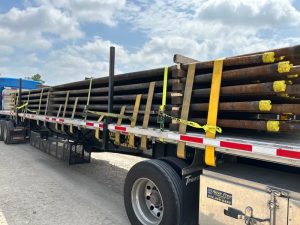Wars against disease and among Slavic peoples have flooded service companies with changes, both in demand for energy and in supply of goods to sell. Oil country tubular goods (OCTG) suppliers are no different, and companies like R&D Pipe Company and Baker Tubulars are broadening their offerings and their markets to make up the difference. And consulting companies like Wood Mackenzie are analyzing markets to understand the trends, showing that prices have doubled since January of 2020.
R&D Pipe Finds Their Niche
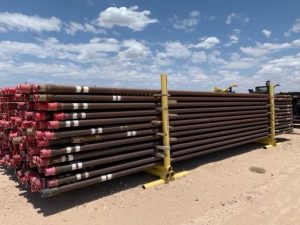 About three years after the fact, the infamous COVID shutdowns are still stretching the supply chain for OCTGs, says R&D’s Permian Manager Chris Holcomb. “You had steel mills shut down for months because of the COVID deal,” he recalled, adding that the mills were already somewhat behind when quarantines began. So now, “when they crank back up they’re going 24/7 but they’re so far behind.”
About three years after the fact, the infamous COVID shutdowns are still stretching the supply chain for OCTGs, says R&D’s Permian Manager Chris Holcomb. “You had steel mills shut down for months because of the COVID deal,” he recalled, adding that the mills were already somewhat behind when quarantines began. So now, “when they crank back up they’re going 24/7 but they’re so far behind.”
Because of that, when mills in China contact him he may open the email, but Holcomb is reluctant to do business there because of the unevenness of the product. It’s like Forrest Gump’s famous box of chocolates: “You never know what you’re gonna get.” Plus, many end users will not buy from a supplier known for selling Chinese product.
Some good quality pipe used to come from Ukraine, he noted, but that supply has dried up with last year’s Russian invasion of the nation.
These supply chain issues have been especially hard on small suppliers, Holcomb said, with some being put out of business. Long lead times necessary for ordering conflict with oil-price-related demand fluctuations to put them at a disadvantage, Holcomb said.
For example, pipe ordered in December of 2021 didn’t arrive at R&D’s yard until October of 2022. Pipe manufacturers require payment up front, “So you’re betting on the hope that prices will stay up,” he said. If in the meantime there’s a demand drop, such as an oil price decline, the price of steel may also drop, but the supplier was already out the higher price—which they can no longer recover in full. “Next thing you know, your margins become razor thin. That’s why you see a lot of the little companies go out of business.”
Larger suppliers, on the other hand, buy in large enough quantities that they may get a better cost, giving them more leeway when prices drop.
At R&D, which is not one of the big companies, they decided mitigate those issues by providing a value-added service that gives them an advantage of speed and convenience. Holcomb explained, “Our niche is that, basically, we take new tubing and we internally plastic-coat it, and we keep it in stock. We are the largest company that does that. It gives us a window in the OCTG business, in that we provide something that our competitors don’t.” Many may not want to store inventory of any sort, coated or not, he mused.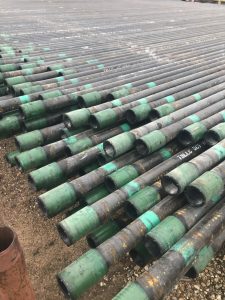
Because the wait time for sending pipe off to be coated is about 10-12 weeks, Holcomb noted that stocking already-coated pipe offers their customers a speed advantage. As an example, he said someone with a saltwater disposal well (SWD) needing a workover in which they discover holes in the tubing would need IPC pipe immediately. “They can’t afford to wait 12 weeks or 10 weeks to send their pipe in to get it coated. There’s your niche, right there.”
In fact, he added, almost every pipe preparation process currently requires long wait times. Heat-treating of the raw pipe for hardness and grading, and end-finishers (threading) have been backed up for six months in many cases. End-user oil companies must therefore project needs 6-12 months out for new wells, workovers, and the like.
This lead time also creates issues for small oil companies, he noted. The multinational E&Ps often have standing orders for large quantities of pipe with large suppliers. So if “Bob’s oil company wants to buy some pipe, if you’re a big pipe company and [a major oil company] calls you and they want to buy that pipe, and then Bob calls you, who’s going to get it?” That preference can be a result of signed contracts as a condition of doing business with the bigger firms, he said.
Like R&D, Baker Tubulars has scouted out new opportunities in order to overcome the market challenges. Explained company President Robert Baker, “We’re strategically expanding our exposure and our services beyond the traditional oil and gas sector.” New targets include water management and agriculture sectors. Baker noted that diversification “minimizes the risks associated with sector-specific fluctuations” and those sectors’ need for pipe makes them a natural extension of the company’s existing expertise.
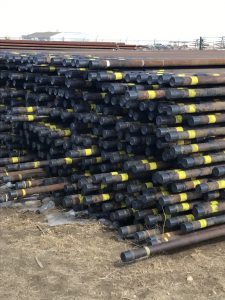 In addition to the COVID-related supply shortages noted by Holcomb, Baker added that those shortages caused pipe prices to skyrocket—not only for pipe itself but also for vessel deliveries, threading, and inspections.
In addition to the COVID-related supply shortages noted by Holcomb, Baker added that those shortages caused pipe prices to skyrocket—not only for pipe itself but also for vessel deliveries, threading, and inspections.
Fortunately, things are better now. “In 2023 we have been prices soften substantially [as much as 50 percent off the highs, and they’re still falling]. Threading and inspection timeframes are back to normal,” he said.
Still, the main challenges for Baker Tubulars involve pipe sourcing and managing inventory to match demand. He explained, “The intricate nature of the industry requires precise inventory management to ensure we have the right pipe available, at the right place, when needed. Our success stems from finding solutions to these challenges. We work closely with suppliers and adopt efficient supply chain practices to address these hurdles.”
Another challenge for anyone in the energy industry involves the ever-changing legislative and regulatory environment, and Baker said his company is watching this activity closely. “Government regulations related to environmental standards, safety protocols, and trade policies are shaping business practices. Staying informed of these changes and ensuring compliance is crucial to maintaining a competitive edge and building a sustainable future.”
Wood Mackenzie Assesses the Evolving OCTG Market in the Permian
One of the factors affecting OCTG demand has been the fall and rise in drilling activity in the Permian Basin. Jeffrey J. Fischer leads a team of researchers who analyzed recent Permian OCTG numbers, in an exclusive to Permian Basin Oil and Gas Magazine.
The first chart shows OCTG prices from January of 2020 through March of 2023, using the January 2020 cost as the baseline. Numbers after that show how prices rose or fell compared to January of 2020. The WoodMac team explained the two lines thus: “The priceline is derived from actual OCTG spend paid by operators and is representative of total market [contract and spot] prices while our cost model represents spot prices. Operators often have long-term contracts in place and adjust prices by other means besides what the spot market is saying, usually meaning total market prices are less volatile than spot prices.”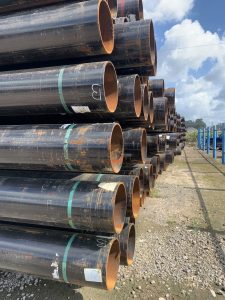
The chart shows how prices dipped with the COVID-related reduction in drilling across the first half of 2020 and returning to the January levels in November of that year. By March 2023, prices had more than doubled in both priceline and spot prices.
By explanation, the WoodMac team noted a boom in drilling with rig counts “averaging above 700 in 2023, a 33 percent increase from 2021.” (See chart 2.) Greater demand for OCTG and other supplies accounts for part of the upward price pressure—but there’s more.
“Amid high demand and limited supply, the U.S. imposed antidumping duties on OCTG items from Argentina, Mexico and Russia in November 2022 that added further pressure on prices,” they explained.
So Much for Quantity, How About Quality and OD?
As for which sizes are in demand, WoodMac notes that 2-7/8” and 5-1/2” sizes “have the highest spend, as they are used for completion/production tubing that runs from the surface to the bottom of the well.” Those lengths run 18,000 feet or more in most cases.
Because the smaller outside diameter (OD) pipe uses L-80 steel, the high use rate of 2-7/8” pipe correlates with the high use of L-80 on the other chart. Plus, other sizes of pipe usually run at much shorter depths, so more of the 2-7/8” is required for each use.
After adjusting for the fact of the greater depths required for 2-7/8”, WoodMac “sees operators often preferring P110 steel in their casing/tubing due to [its] high quality material [required for] complex wells” involving ever-longer laterals.
Paul Wiseman is a freelance writer in the oil and gas industry. His email address is fittoprint414@gmail.com











